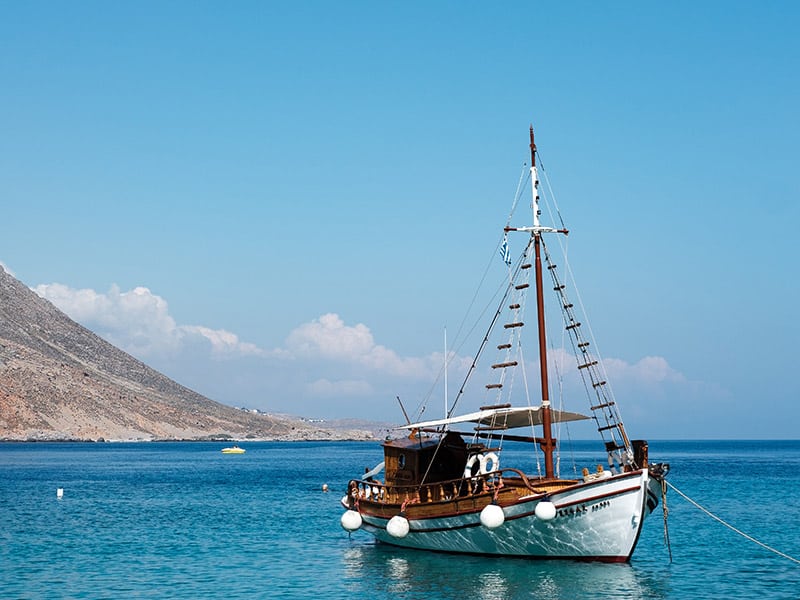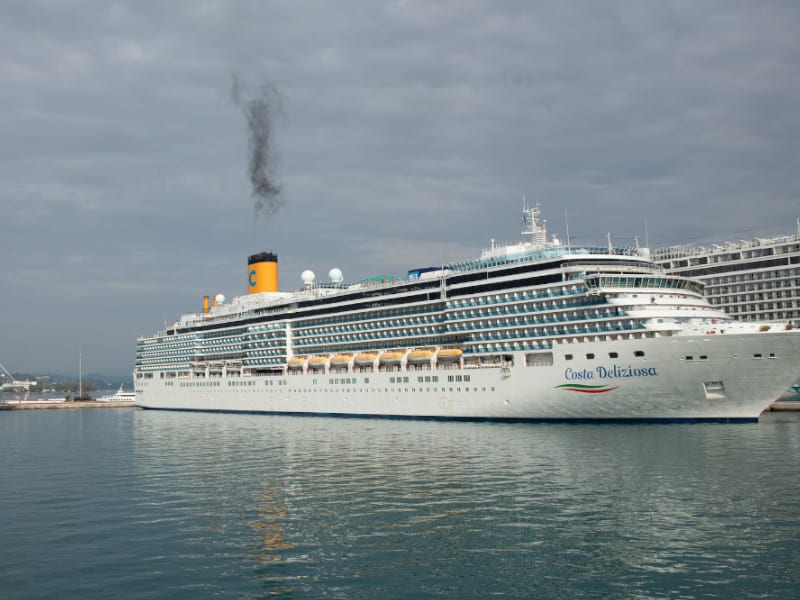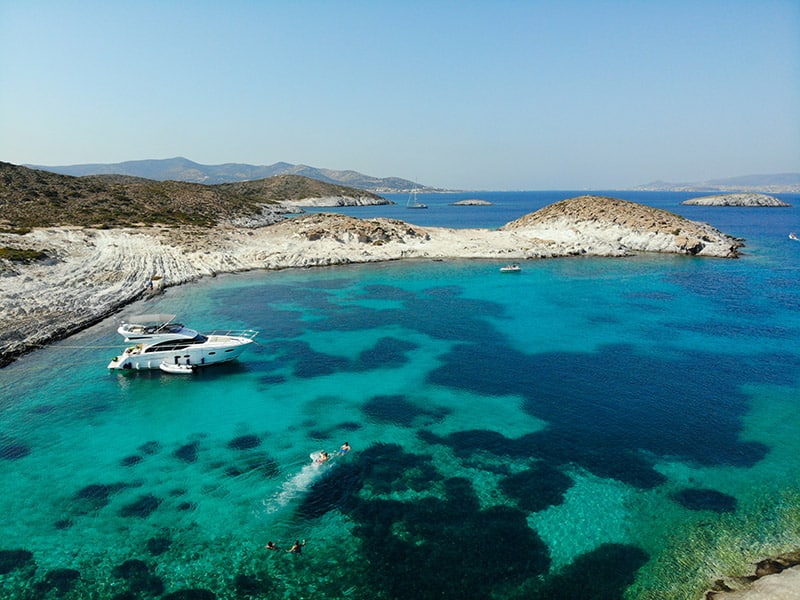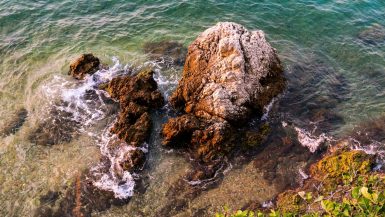
There are few destinations in the world as tempting to island hoppers as the home of filo pastry and Zorba dancing. This sun-kissed part of southern Europe has a whopping 6,000 isles in total, of which a massive 227 are inhabited all year round, and several rank among the most popular sun, sea, and sand getaways in the world. Bucket-list-busting adventures are just waiting to be had between the Ionian Sea in the west and the Aegean Sea in the east. But how to travel between islands in Greece?
That’s what this guide is all about. It has all the info you need about how to travel between islands in Greece, with details about the regular ferries that link up many of the major names and a guide to flying between the islands that have their own airports.
We think you’ll quickly notice two things. First, island hopping in Greece is going to be AMAZING. From the crumbling monuments of Rhodes to the white-washed villages of Santorini, there are incredible things to see around every corner. Second, planning this sort of trip shouldn’t be a chore. The archipelagos of this Mediterranean nation are connected by an extremely comprehensive boat network, and are perfect for skippers keen on chartering their own yachts.
First: A bit of Greek geography

Before we delve into the detail of how to travel between islands in Greece, it’s worth getting to grips with a bit of basic geography. So, here goes…
Greece has a whopping 6,000 islands in all. All of those are spread between two main seas. There’s the Ionian Sea, which is on the western side of the country. Then there’s the Aegean Sea, which hosts the vast majority of Greek islands as it spreads from Thessaloniki on the mainland to Crete in the south.
It’s worth knowing that the Ionian Islands (places like Zakynthos and Kefalonia) and the Aegean Islands (places like Santorini and Mykonos) aren’t linked together by direct ferries. To move between them, you’ll either need to fly, drive, or catch long ferry links via Athens. So, you’re best off choosing one region for your island hopping and sticking to that.
Island groups in Greece

To make things just a little bit more complicated, the Aegean Islands can be broken down into a few smaller groups. It’s possible to move between these on ferries, since they aren’t as far away from each other as the regions of the Ionian and the Aegean themselves, but some trips (like Milos to Rhodes) can be long ones. What’s fun is that each island group has its own unique vibe, culture, food, and history. The island groups to know about are:
- The Cyclades – Probably the most famous island group in the whole country, the Cyclades are home to iconic islands like Mykonos and Ios. You can do a whole island hopping trip here without trouble. There’s loads to see, from the cliffs of Santorini to the whitewashed beaches of Milos.
- The Dodecanese – The Dodecanese are the easternmost chain in Greece. They are also the hottest, so tend to have slightly longer seasons than other groups. There are 15 main islands in the group, led by Rhodes and Kos.
- The Sporades – A small group of islands that dot the Aegean north of Athens. These are known for their lush, pine-covered interiors and gold-sand beaches. If you come to the Sporades then you’re likely to be limited to the Sporades, since there aren’t many ferries coming and going to other groups.
- Saronic – The closest islands to Athens. This group includes historic Aegina, arty Hydra, and rocky Spetses. If you don’t have much time then pick these. Travel out to them takes no more than an hour from Athens.
Finally, there’s Crete. Crete is the largest island in the country. It’s also the southernmost island in Greece, which means it can take some time to get to (usually a full day on the boat or a whole overnighter from Athens). We think it’s a great place to begin or end a trip, but not so fantastic for a mid-trip stop, since it’s bound to take you away from the main ferry routes through key groups like the Cyclades.
Traveling by ferry

The vast majority of people wondering how to travel between islands in Greece will only need to know about one mode of transport: Ferries.
Countless public ferry connections operate between the islands — and from the mainland — during the peak of summer. In fact, we’d go as far as to say that Greece has one of the most comprehensive public boat networks in the world. If you’re willing to make changeovers and juggle bookings with multiple companies, then it’s usually possible to do any A to B in the country you can think of, perhaps with the sole exclusion of moving between the two seas, the Ionian and the Aegean.
Ferry services vary in size, speed, and frequency; it’s worth remembering that whilst a car ferry might transport you between islands in two or three hours, a smaller and more traditional vessel might take much longer. Then there are fast catamarans, high-speed boats, and larger passenger boats, all of which run on their own timescale. It’s also important to consider that boat services can also sometimes be delayed or postponed due to high winds, poor visibility or stormy weather, although this is much less common during the warmer months.
The nature of the ferry links in each island group can differ a lot, so it makes sense to dig a little deeper and focus on the boats region by region…
Ferries between the Cyclades islands

If it’s your first time visiting the islands of Greece, ferries between the Cyclades are some of the easiest to navigate. We’d actually say that this is the single best region for island hopping overall, since almost all of the mainstay islands (Santorini, Ios, Naxos, Mykonos) are well served by long-distance ferries from both Athens, Crete, and the Dodecanese islands in the east. From those, it should also be easy to get onward connections on smaller boats to the lesser-known members of the Cyclades, from Milos to Folegandros.
It’s worth knowing that the two central islands in the Cyclades – Paros and Naxos – act as a sort of hub for most big boat companies. Almost all of the big boats from Athens and other island groups will stop at least one of those, making onward trips to any other island in the chain a real cinch. Some of the Cyclades are so close to each other that it’s even possible to do day trips for those who prefer not to spend too much time at sea. It takes a mere 20 minutes to cross from Mykonos to Tinos, for example, and there are even shorter links between Paros and Antiparos every single day.
There are some key connections within the Cyclades islands that most island hoppers in the region are likely to make at least once. They are:
- Mykonos to Santorini (2.5 hours) – Probably the most popular ferry connection in Greece, this one takes you from the amazing caldera island to the party isle of the Cyclades, taking just 2.5 hours in all. There are usually over 10 departures each day, but we’d still book ahead of time for peak season travel.
- Paros to Mykonos (30 minutes to 1.5 hours) – Lots of people make this trip, as it takes you from one of the main ferry hubs of the region to the good-time island of Mykonos, all in as little as 30 minutes if you opt for the fast boat.
- Mykonos to Ios (1.5 hours) – There are multiple daily ferries running this route. They link up the two major party islands of the chain in 1.5 hours, sometimes a little more.
- Ios to Santorini (1.2 hours) – This trip takes you to the southernmost Cycladic island and is a good option for finishing off a trip in the amazing island of Santorini.
Ferries between the Ionian Islands

If you decide you want to hit the cotton-white sands of the Ionian Islands out in western Greece then you should expect travel to be just a touch harder than over in the Aegean. There’s not the same comprehensive island-to-island ferry network in the parts. Mostly, routes go to and from two major ports on the mainland: Igoumenitsa and Patras. That means getting from one isle to the next will often involve a changeover, and take a little longer.
That’s the bad news. The good news is that the ferry schedule in the Ionian islands is pretty simple and usually runs on time, so making those connections shouldn’t be too hard. There are only a handful of large islands that are actually served by public ferries, too, so there’s not the same overload of choice you get in the Aegean. Common routes go from Kefalonia down to Lefkas and then over to either Ithaca or further south to Paxos and Antipaxos.
Ferries between the Dodecanese Islands

The Dodecanese chain probably has the second most prolific range of ferries in Greece, next to the Cyclades. It’s also very well linked to Athens, Crete and popular hotspots like Santorini by long-distance ferries, but bear in mind that those can take some time (often a whole night on the boat). The two main hubs in the region are Kos and Rhodes. Aim for either of those and you should find it relatively easy to get a boat to any other member of the chain.
The most common routes around the Dodecanese islands are from Rhodes to Kos, Rhodes to Symi (a romantic island with a charming Venetian harbor town), and from Kos to Kalymnos (a really quiet island that’s within eyeshot of Turkey).
Ferries between the Saronic Islands

We’ve already mentioned how we think the Saronic Islands are the best option for those who are short on time. That’s because they’re super, duper close to Athens. The first – Aegina – is less than an hour by boat from the major port in Piraeus. From there, it should be really easy to string together onward island hops to Poros (a little-known island with a pretty yachting town), Hydra (a famously artsy isle with bare back country and super-clear water), and then Spetses (a rugged, rocky island with grand ports), before returning to Athens.
Long-distance ferries in Greece

If you’re flying into Athens and not directly into an island destination or a port near the coast, then there’s a good chance that you’ll be looking to take one of the long-distance ferries in Greece. These tend to be huge boats – more like a cruise ship than a quick catamaran. They can host hundreds of people at once and make the longest journeys of all. They leave regularly from the big port of Piraeus (the main port in Athens), but also from smaller ports on islands like Crete, and some others on the Greek mainland (Patras, Thessaloniki).
Look at the long-distance ferries as a good way to start your journey. They’ll whisk you from the big city and the shores to the heart of island chains, where it’s possible to switch to smaller boats to take you out to lesser-known islands. They are also great for moving between the various island groups – there are regular connections from Athens that go through the Cyclades and then our to the Dodecanese or down to Crete, for example.
Travel by Plane

Although some people may prefer taking to the skies when traveling between destinations, inter-island flights in Greece are often hard to come by. Of course, international flights arrive at tourist destinations like Crete, Rhodes and Corfu daily, and flights from Athens to the islands are relatively frequent and operated by local airlines. However, finding flights between smaller islands isn’t as simple mainly because they often don’t exist!
There are really only two reasons you’d ever get near a plane during an island hopping trip. The first is to fly into Greece in the first place. There are now loads of short-haul connections with budget carriers like easyJet, Ryanair, and Wizz that can get you right into the middle of an island chain like the Cyclades from the get-go, no long-distance ferry from Athens required. The second is if you want a quick way to move between the various regions, like going from the Aegean Sea to the Ionian or down to Crete, for example.
Picking an island group

No two islands in Greece are quite the same. Although some have become more commercialized in recent years, each and every islet is shaped by thousands of years of history. Deciding which Greek island — or islands — is best to visit for you will be dependent on who you’re traveling with, what you enjoy doing, and how much time you wish to spend there.
Crete is the largest of the Greek islands, located almost 100 miles to the south of the mainland. This mountainous getaway is top of the list for many travelers visiting the Greek islands, with everything from beautiful beaches to historical castles, plus lots of organized tours and easily accessible attractions for tourists. Further north, the emerald isle of Corfu is only a two-hour flight away. Another firm favorite with tourists looking to experience the islands of Greece, here you’ll find the UNESCO World Heritage protected Old Town and countless ancient buildings.
Undeniably, the Cyclades is home to some of Greece’s most well-known destinations, including the infamous isles of Mykonos and Santorini. Packed with tiny white-walled streets and boasting famous clifftop sunsets, every trip to Greece should include one of these two inspiring islets. If you really can’t decide which of the two to visit, don’t worry — they’re only a few hours apart by ferry, which is why we usually say this is the overall best place for traveling island to island in the country.
When should I visit the islands of Greece?

Of course, the summer months – from May to September – are the best time to experience the peak of the heat and the sunshine in Greece. However, July and August are typically exceptionally busy (not to mention the most expensive times of year to travel), so it’s best to arrive before or after if possible.
If traveling in the summer, keep in mind that flights, ferries, and accommodation can book up quickly, so it pays to be prepared. That’s especially true of the country’s major draws: Santorini, Crete, Rhodes, and Kefalonia. You might have more luck with last-minute travel planning on smaller islands like Ithaca or Amorgos. Conversely, if you travel out of season, ferry schedules are reduced and can be further affected by bad weather, so ensure you have time and money to allow some flexibility in your plans in case you do encounter any unexpected delays.
How long should you spend island-hopping in Greece?

Deciding how long to spend exploring the islands of Greece will depend on exactly how you want to spend your time and how long you have. If you want to spend less than a week in Greece, it would be a good idea to stick to one group of Greek islands. Ferries are typically a slow mode of transportation to take, so whether it’s the Cyclades or the Aegean islands, traveling only to nearby islets which share more frequent ferry routes will mean you’ll have the chance to visit more of these breathtaking destinations in the short time you’re there.
If you have ten days or two weeks to spend discovering the Greek islands, you can broaden your horizons and venture much further. If you’re starting your trip in Athens, the Argo-Saronic islands are a fantastic starting point. Located less than an hour from the port of Piraeus, these islands feature everything from golden sand beaches to pine-clad forests, making them a popular choice with Athenians for a weekend break. From there, the world – or Greece – is your oyster; venture on to the Dodecanese islands to discover neoclassical towns and mountainous landscapes, capture photographs of the unforgettable sunsets from a cliff top in the Cyclades and stop to see the small Sporades island of Skopelos, the filming location for popular movie Mamma Mia.
How much does it cost to travel between islands in Greece?

So you know how to travel, but how much is it going to cost? If you decide to travel around the Greek islands by ferry, prices can vary depending on which route you take and the time you’re traveling, with the highest prices typically during the summer. Tickets can range from 10 euros up to over 100 euros, but if you’re looking to save some money and stick to your budget, there are easy ways to do this.
Regular services between some of the most popular islands – for example, Mykonos and Santorini – tend to be the cheapest routes, but this sailing would take approximately four hours to cross the waters. However, by spending a little extra, you could cut your journey time by up to two hours. Another savvy way to keep track of your spending is to check online for tickets in advance; there may not be a huge difference in price, but every little helps, and booking before arriving in the port will also give you peace of mind that you can hop aboard with ease.
Alternatively, if you’re traveling by plane, you’ll find prices are typically based on which island you’re looking to fly to – but don’t assume they’ll always cost more than traveling by ferry. Santorini is notoriously expensive (not just for flights), but islands like Rhodes, Crete and Corfu tend to be more affordable if booked closer to the time of travel. Of course, it’s also dependent on the time of year – flights between January and March will inevitably be some of the cheapest. If you are traveling with strict costs in mind, ferry is definitely the best way to travel in Greece – and if you want to avoid encountering any budget-blowing fares, try to keep to the quieter and less popularized islands like Naxos and Paros.
How to travel between islands in Greece – our conclusion
Ferry is certainly the most popular way to travel between islands in Greece. We’d say something like 90% of people on hopping trips relies on the public ferry network. The good news is that it’s among the most comprehensive ferry networks in the world, with short connections to smaller islands and longer connections to bigger islands alike. You can also select from a range of different types of boats, from fast catamarans to big, cruise-like vessels that have cabins for comfy overnight trips. Flying between the islands isn’t the best option since only some have airports, though taking to the skies can be a good option when you want to move from one region to another and cover more distance.


